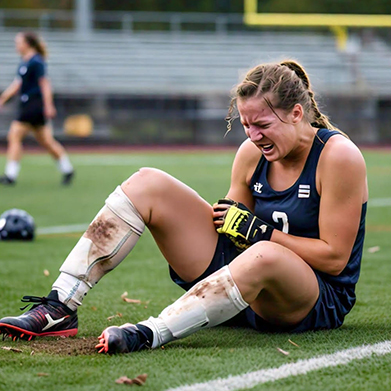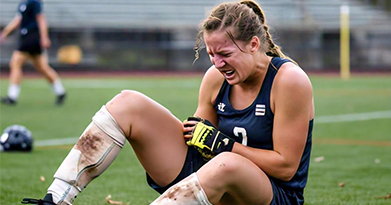
The anterior cruciate ligament (ACL) is a crucial stabilizer of the knee. You may have heard of this ligament in relation to sporting injuries such as those suffered by your every day weekend warrior or professional athlete. The ACL connects the femur (thigh bone) to the tibia (shin bone) and is found within the knee joint itself. The primary function of the ACL is to prevent the shinbone from moving forward (or anterior in medical jargon) relative to your thighbone. This is the most well-known function of the ACL among the general public and is what you see medical teams testing on the field when your favorite athlete has sustained a knee injury. Lesser known to the public is that the ACL is also an important rotational stabilizer of the knee and prevents the shinbone from internally rotating relative to the thighbone.
With these functions in mind, you can see how sporting activities, particularly ones that involve sharp changes in direction (cutting movements) and jumping, are particularly high risk. These activities place significant stress on the ACL because of the biomechanical demands placed on the knee in order to perform the desired movement. Consider, for instance, a soccer player running up and then jumping to head a cross. When the player lands the knee must absorb both their momentum horizontally as they were running and vertically as they land. These forces naturally tend to cause the shinbone to move forward in relation to the thigh particularly if they land with their foot flat and hips bent. When the force generated by the movement exceeds the strength of the ACL fibers, the ACL begins to fail with injuries ranging from strains (partial tearing) to complete detachment or disruption of the ACL from its natural position. In people who are done growing, the most common site of ACL tear is at its attachment to the thighbone or in the mid-substance (middle) of the ligament. As many as 70% of patients will hear or feel a “pop” at the time of injury. An example of an ACL tear in a high-level athlete is shown in this video, in which Jameson Williams from the University of Alabama tears his ACL while competing against the University of Georgia in the national championship game. You can see the knee clearly pivot as he performs a cutting maneuver.
Contrary to what some in the public believe, approximately 70% of ACL injuries are non-contact injuries. There are many thoughts as to what factors put someone at risk for ACL tear or injury beyond what activity they're performing. Some of these risk factors include certain natural variations of bony alignment, hypermobility (hyper-flexibility), and younger age. Female athletes have been shown to have at least twice the risk of ACL tear compared to their male counterparts performing the same activities. While not totally understood, this is thought to be caused in part by differences in activation of the muscles surrounding the knee. One such relationship is between the quadriceps (muscles that straighten the knee) and hamstrings (muscles that flex the knee). Poor jumping mechanics particularly landing with knees into valgus (bowed slightly to the outside) also is known to play a large role in the increased risk seen in our female athletes. As a result, teaching proper landing mechanics is always a part of our postoperative physical therapy protocols when rehabbing from an ACL reconstruction or repair. Regardless of how the ACL is injured, our team is here ready to help restore a functional ACL and get you back to the activities you enjoy.







